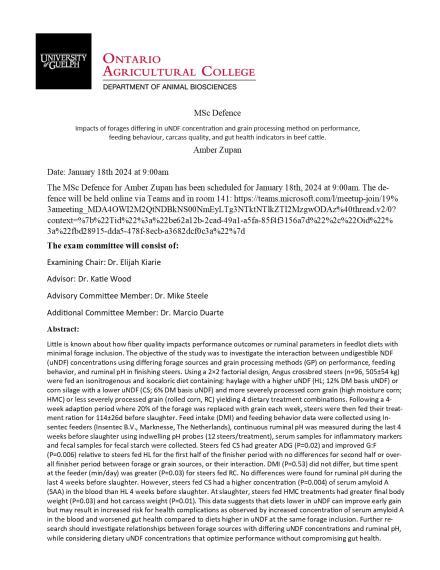Amber Zupan's MSc Defence
Date and Time
Location
Room 141 and teams: https://teams.microsoft.com/l/meetup-join/19%3ameeting_MDA4OWI2M2QtNDBkNS00NmEyLTg3NTktNTlkZTI2MzgwODAz%40thread.v2/0?context=%7b%22Tid%22%3a%22be62a12b-2cad-49a1-a5fa-85f4f3156a7d%22%2c%22Oid%22%3a%22fbd28915-dda5-478f-8ecb-a3682dcf0c3a%22%7d

Details
Impacts of forages differing in uNDF concentration and grain processing method on performance, feeding behaviour, carcass quality, and gut health indicators in beef cattle.
Little is known about how fiber quality impacts performance outcomes or ruminal parameters in feedlot diets with minimal forage inclusion. The objective of the study was to investigate the interaction between undigestible NDF (uNDF) concentrations using differing forage sources and grain processing methods (GP) on performance, feeding behavior, and ruminal pH in finishing steers. Using a 2×2 factorial design, Angus crossbred steers (n=96, 505±54 kg) were fed an isonitrogenous and isocaloric diet containing: haylage with a higher uNDF (HL; 12% DM basis uNDF) or corn silage with a lower uNDF (CS; 6% DM basis uNDF) and more severely processed corn grain (high moisture corn; HMC) or less severely processed grain (rolled corn, RC) yielding 4 dietary treatment combinations. Following a 4-week adaption period where 20% of the forage was replaced with grain each week, steers were then fed their treatment ration for 114±26d before slaughter. Feed intake (DMI) and feeding behavior data were collected using Insentec feeders (Insentec B.V., Marknesse, The Netherlands), continuous ruminal pH was measured during the last 4 weeks before slaughter using indwelling pH probes (12 steers/treatment), serum samples for inflammatory markers and fecal samples for fecal starch were collected. Steers fed CS had greater ADG (P=0.02) and improved G:F (P=0.006) relative to steers fed HL for the first half of the finisher period with no differences for second half or overall finisher period between forage or grain sources, or their interaction. DMI (P=0.53) did not differ, but time spent at the feeder (min/day) was greater (P=0.03) for steers fed RC. No differences were found for ruminal pH during the last 4 weeks before slaughter. However, steers fed CS had a higher concentration (P=0.004) of serum amyloid A (SAA) in the blood than HL 4 weeks before slaughter. At slaughter, steers fed HMC treatments had greater final body weight (P=0.03) and hot carcass weight (P=0.01). This data suggests that diets lower in uNDF can improve early gain but may result in increased risk for health complications as observed by increased concentration of serum amyloid A in the blood and worsened gut health compared to diets higher in uNDF at the same forage inclusion. Further research should investigate relationships between forage sources with differing uNDF concentrations and ruminal pH, while considering dietary uNDF concentrations that optimize performance without compromising gut health.